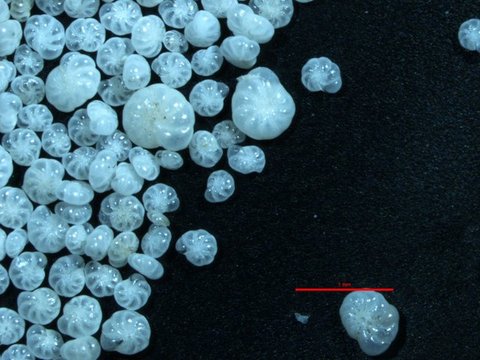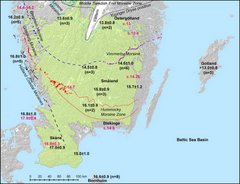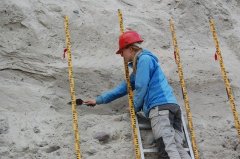Research > Baltic Sea during the last ice age
The Baltic Sea basin during the last ice age
Sediment cores from Kriegers Flak in the SW Baltic Sea.
The last glacial period (the Weichselian, 115-11.7
ka) is characterized by major glaciations on the
northern hemisphere. By studying the traces of
these past ice sheets we get a unique opportunity to
study the dynamics of an ice sheet over large
timescales, such as an ice age cycle, and during
highly variable climate conditions.
Pieces of soft, white, chalk have been picked up by the ice sheet and mixed with the other sediments.
In this project Middle Weichselian sediments were studied
in sediment cores from Kriegers Flak,
a shallow area in the southwestern Baltic Sea.
In the lowermost and oldest part of our sediment cores we found
a soft chalk bedrock overlain by the oldest till identified on Kriegers Flak.
We suggest that this till, which we dated to the Early or Middle Weichselian, was
deposited during the Ristinge advance, which implies an age of c. 55-50 ka.

Foraminiferas. The red line is 1 mm long.
Following the deglaciation after this advance, isostatic depression
enabled a marine influence in the southern Baltic
Basin. A clay unit with a low-diversity
benthic foraminifera fauna indicative of cold water
and low salinities, was deposited. This period was followed
by a forced regression on Kriegers Flak, probably
caused by a combination of isostatic rebound and a
falling global sea level, which led to a period of nondeposition
and erosion.
Between 42 and 36 cal. ka
BP, wetlands and shallow lakes existed on Kriegers
Flak. Macrofossil and pollen analyses
suggest tundra-like, or forest tundra-like vegetation,
possibly with birch and pine in sheltered locations.
From 28.5 to 26 ka, a thick succession of
glaciolacustrine clay was deposited at
Kriegers Flak indicating a damming the Baltic Basin
by an ice advance into Kattegat.
A better understanding of the Weichselian history of the Baltic Sea basin was
also one of the goals of the IODP (International Ocean Discovey Program)
campaign in the Baltic Sea during 2013. Their results can be found at the
IODP web page.
Read more
 New deglaciation chronology for south Sweden
New deglaciation chronology for south Sweden
In this study we present new age constraints for the deglaciation of southern Sweden based on cosmogenic surface exposure dating.
We also provide a map with suggested deglaciation ages based on the new data and selected existing dates from the region.
Read more.
 Research expedition to Taymyr
Research expedition to Taymyr
During the summer of 2012 I participated in a seven week long expedition to Taymyr. The aim of the expedition was to
date the glaciations in the region. We therefore travelled in zodiacs along the Luktakh, Upper Taymyr and Logata rivers,
a total distance of almost 350 km.
Read more.
 Ice free conditions in central Sweden in the middle of the last ice age
Ice free conditions in central Sweden in the middle of the last ice age
The Scandinavian ice sheet at its largest extent covered large parts of northern Europe. However, during parts of the last ice age the ice sheet was
significantly reduced. In this study we have studied sediments outside of Idre, west-central Sweden, and found
that the area must have been ice free at som point between 50 and 40 thousand years ago, in the middle of the last ice age.
Read more.
Back to the research overview

